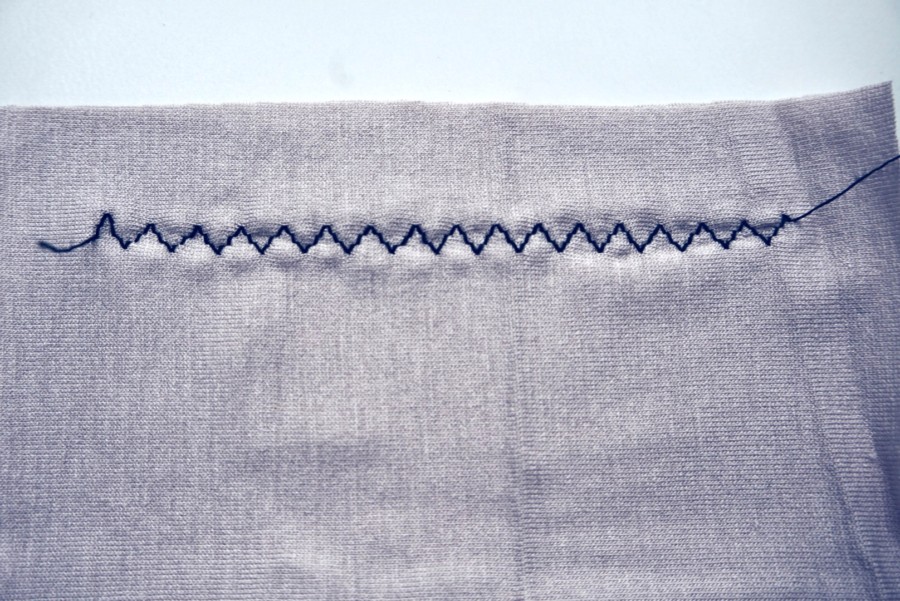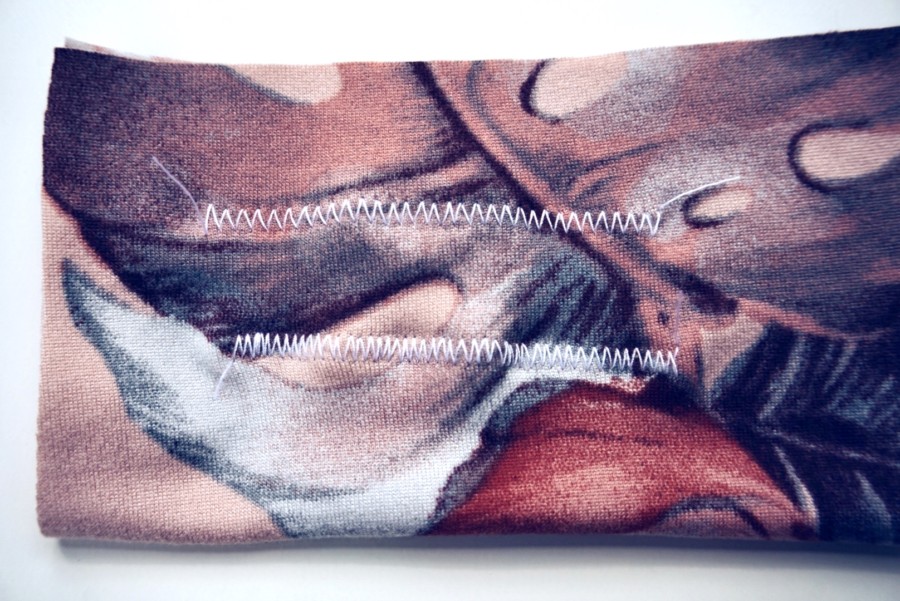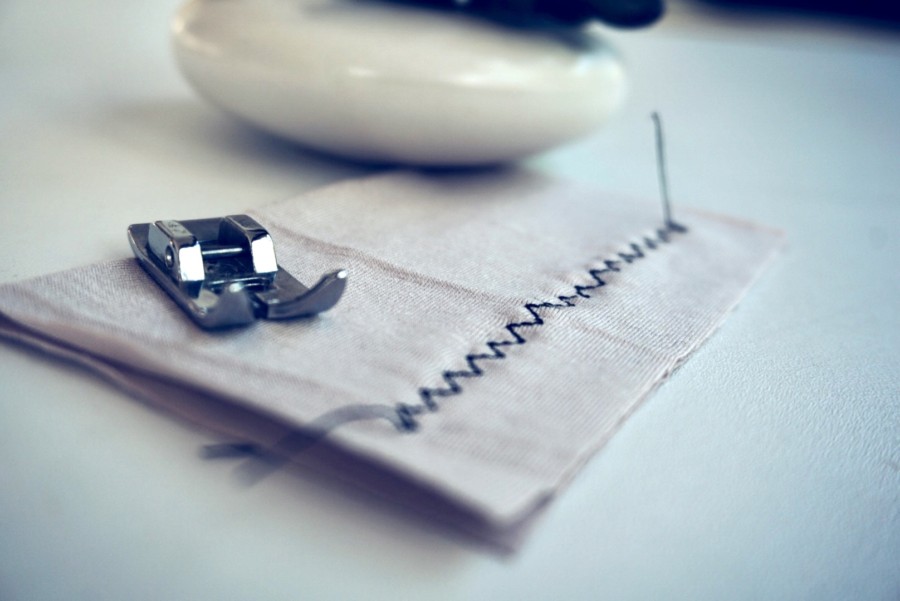If you have moved on to sewing knit fabrics then it is time you learned everything you ever needed to know about using a zigzag stitch. If you got here because you are learning how to sew bras and underwear you are in the right place. This post will teach you about all the the different types of zigzag stitches and how to adjust your sewing machine accordingly.
What is a Zigzag Stitch?
A zigzag stitch is exactly as it sounds, a stitch that looks like a zigzag. It is a strong stitch that locks in the raw edge of the fabric tightly but still allows stretch because of the zigzag motion of the thread. There are variations on the zigzag stitch depending on what you are sewing. There is a narrow zigzag stitch, a 3-step zigzag stitch or a wide zigzag stitch to name a few.
There are a variety of ways you can use a zigzag stitch and while it is commonly used for stretch fabrics it is also used on wovens. Let’s take a look at what these different types of zigzag stitches are, how to adjust your machine and the purpose of a zigzag stitch.
What is the Purpose of a Zigzag Stitch?
The purpose of the zigzag stitch is to move with the stretch of a fabric offering extra strength to the seam while simultaneously preventing the threads from breaking. It is also used to encase raw edges which prevents fraying and removes bulk from a seam typically in woven fabrics.
What is a Zigzag Stitch Used For?
A zigzag stitch is commonly used to sew knit fabrics for any variety of garment styles. It is used in lingerie for underwear and bralettes. It is used in athletic wear, dance wear, and swimwear. It is also commonly used in woven fabrics for encasing raw edges and to prevent fraying. It is a common utility stitch used in hemming, mending, buttonhole making/button sewing and overcast stitching on a standard home sewing machine.
Zigzag Stitch Basics

When sewing a zigzag stitch you need to switch out your presser foot to a Zigzag Presser Foot. It is also important to adjust the Needle Thread Tension for a Zigzag Stitch. Correct needle thread tension for the zigzag stitch is the bobbin thread not showing the right side of the fabric but the needle thread shows very slightly on the wrong side of the fabric. Most importantly choose the correct zigzag stitch setting/stitch pattern. There is the standard setting which will apply to all your zigzag stitches except the 3-step zigzag stitch which has its own setting/stitch pattern setting.
What is a Standard Zigzag Stitch?

- Uses/Purpose: A standard zigzag stitch is used to sew knit fabrics, sew elastic onto knit fabric, finishing raw edges, and attaching appliques
- Machine Settings: Stitch Length 2 and Stitch Width 2 to 3
- Needle Thread Tension: 2 to 5
What is a Narrow Zigzag Stitch?

- Uses/Purpose: A narrow stitch reinforces points of strain. A narrow zigzag stitch is often referred to as a bar tack. It is commonly used on lingerie straps, pocket edges and corners. It is also great for repairing holes in woven garments such as jeans.
- Machine Settings: Stitch Length .05 to 1.5 and Stitch Width 0.5 to 2.5
- Needle Thread Tension: 1 to 4
What is a Wide Zigzag Stitch?

- Uses/Purpose: A wide zigzag stitch is used for sewing knit fabrics, sewing elastic onto knit fabric, finishing raw edges, and appliques
- Machine Settings: Stitch Length 2.5 to 4 and Stitch Width 3.5 to 5
- Needle Thread Tension: 2 to 5
What is a 3-Step Zigzag Stitch?

- Note: Choose the stitch pattern selector for a 3-step zigzag stitch
- Uses/Purpose: The 3-step zig-zag stitch is stronger than the standard zig-zag stitch which is preferable for lingerie since it allows the fabric to stretch while being worn.
- Machine Settings: Stitch Length 1 to 4 and Stitch Width 5 (these can be adjusted depending on how narrow you would like the stitch)
- Needle Thread Tension: 1 to 4
What is a Satin Stitch?

- Uses/Purposes: The satin stitch is a long but narrow decorative stitch. It is used as an overcast stitch on raw edges typically on table linens and blankets. The satin stitch is also used in applique.
- Machine Settings: Stitch Length 0.5 to 1 and Stitch Width 5
- Needle Thread Tension: 1 to 5
How to Sew a Zigzag Stitch?
Now that you are ready to sew a zigzag stitch it is time to determine which stitch is right for you. Adjust your machine accordingly and be sure to test a scrap piece of your fabric before you start sewing your final garment. When you are testing your scrap you want to make sure that the needle thread tension is correct- not too tight or too loose. You also want to make sure you picked your desired stitch length and width.
- To begin sewing your final fabric, lower your zigzag presser foot onto your fabric.
- Then lower your needle manually into the fabric. Make sure your needle thread is tight by pulling it away from the machine. It should resist the pull.
- Sew about three stitches forward then reverse the stitch to secure it.
- Continue sewing forward from here and reverse stitch at the end of your seam.
How to secure your Zigzag Stitch?
We touched on this briefly above, but to secure your zigzag stitch you need to do a reverse stitch. I like to sew a few stitches then reverse then move forward on my normal stitch path when sewing. You will also need to reverse at the end of your seam to secure both ends.
Other Types of Zigzag Stitches:
Applique Stitching: You can use the zigzag stitch to baste applique pieces onto your fabric. To applique your piece to your fabric, zigzag stitch around the raw edge.
Monogramming Stitching: Use a satin stitch to sew letters onto your fabric. You can outline the letters first with tailor’s chalk or a washable fabric marker.
Button Sewing: You can use the zigzag stitch to sew buttons to your garment. The settings you choose will depend on the distance between the button holes on the button.
Overcast Stitching: You can use a zigzag stitch to finish the raw edges of a garment. You will need to leave a small allowance between the stitch and the raw edge which you can trim after.
Where to Buy a Sewing Machine
All standard home sewing machines come with a zigzag stitch option. It is important to read your machine’s manual when testing out your machine’s zigzag stitch capabilities. If you would like a standard home sewing machine recommendation check out my Sewing Machines Recommendations here.
Conclusion
As you can see the zigzag stitch is a simple but mighty stitch that you will utilize in a variety of different ways. It is one of the most important stitches for sewing lingerie and especially important if you do not have a serger sewing machine. Remember to always test your stitch, zigzag or not before you sew your final pattern pieces and don’t be afraid to experiment!
Happy sewing!


